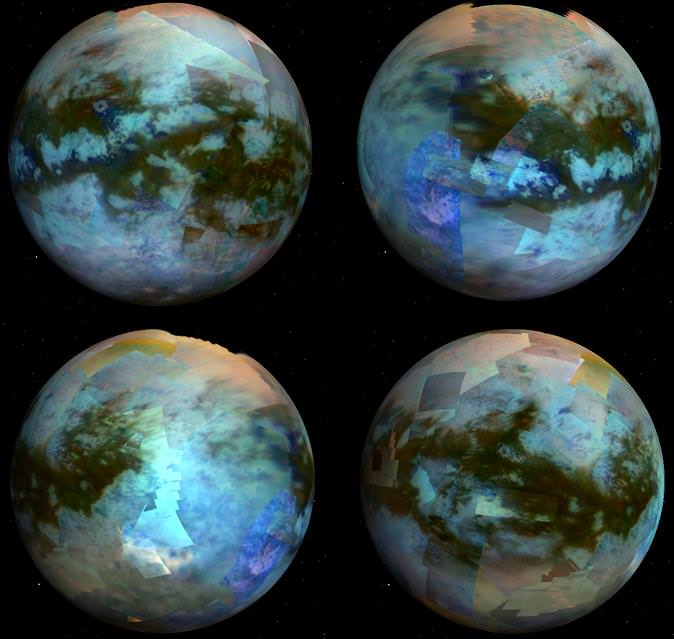[/caption]
At the University of Nantes, a group of international scientists have been piecing together one of the most amazing jigsaw puzzles of all times… a color image of Saturn’s moon, Titan. For six years the Cassini mission has been busy gathering images and the resulting compilation was presented on October 4 by Stephane Le Mouelic at the 2011 EPSC-DPS Joint Meeting in Nantes, France. While it might not win the Cannes Film Festival, it’s certainly near and dear to an astronomer’s heart…
During the first seventy fly-bys of the famous Saturnian satellite, the Visual and Infrared Mapping Spectrometer (VIMS) gathered imaging records. But sewing together such a large quilt of information wasn’t an easy task. Not only does each image have to be adjusted for differences in lighting conditions, but a pixel-by-pixel match up has to occur to take atmospheric distortions into account. Titan’s methane rain and nitrogen atmosphere isn’t conducive to easy imaging and only a narrow band of infrared wavelengths allow us to take a closer look at the hidden, frozen surface. However, the results have been spectacular and little by little some very “terrestrial” features have come to light.
“As Cassini is orbiting Saturn and not Titan, we can observe Titan only once a month on average. The surface of Titan is therefore revealed year after year, as pieces of the puzzle are progressively put together.” says Le Mouelic. “Deriving a final map with no seams is challenging due to the effects of the atmosphere – clouds, mist etc. – and due to the changing geometries of observation between each flyby.”
Since 2004, Cassini has made 78 fly-bys of the exotic frozen world and another 48 are planned over the next five years. However, VIMS has had very few chances to image Titan with a high spatial resolution. While this still leaves many areas in the proverbial dark, all this can change in the future.
“We have created the maps using low resolution images as a background with the high resolution data on top. In the few opportunities where we have VIMS imagery from the closest approach, we can show details as low as 500 metres per pixel. An example of this is from the 47th flyby, which allowed the observation of the site where the Huygens descent module landed. This observation is a key one as it might help us to bridge the gap between the ground truth provided by Huygens, and ongoing global mapping from orbit, which will continue up to 2017.”
And what does the future hold? Along with updated spatial coverage, the team plans on documenting Titan’s changing seasons from both an atmospheric and surface viewpoint. Changes that are just now beginning to occur.
“Lakes in Titan’s northern hemisphere were first discovered by the RADAR instrument in 2006, appearing as completely smooth areas. However, we had to wait up to June 2010 to obtain the first infrared images of the northern lakes, emerging progressively from the northern winter darkness,” says Le Mouelic. “The infrared observations provide the additional opportunity to investigate the composition of the liquids within the lakes area. Liquid ethane has already been identified by this means.”
Fill ‘er up… We’ll be watching!
Original Story Source: Europlanet News Release. For an even more impressive look, check out the Animation of Titan Mosaic.


Soo beautiful yet so deadly. At least for yumens.
The science and the article – absolutely compelling!